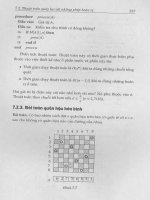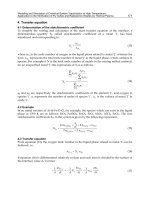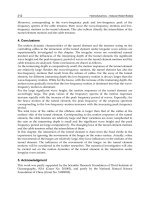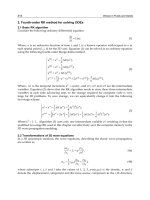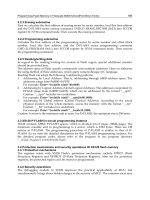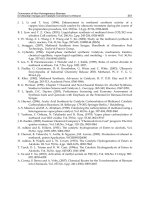Volume 21 - Composites Part 10 pdf
Bạn đang xem bản rút gọn của tài liệu. Xem và tải ngay bản đầy đủ của tài liệu tại đây (6.7 MB, 160 trang )
Introduction to Post-Processing and Assembly
Introduction
Introduction to Post-Processing and Assembly
Flake C. Campbell, The Boeing Company
Polymer-Matrix Composites
Introduction to Post-Processing and Assembly
Flake C. Campbell, The Boeing Company
Metal-Matrix and Ceramic-Matrix Composites
Machining, Trimming, and Routing of Polymer-
Matrix Composites
Introduction
Machining, Trimming, and Routing of Polymer-Matrix Composites
Lawrence F. Kuberski, Fischer U.S.A.
Machining Operations
•
•
μ
Machining, Trimming, and Routing of Polymer-Matrix Composites
Lawrence F. Kuberski, Fischer U.S.A.
Cutting Tools For Machining
Fig. 1 Typical diamond brazed cutting tool
Fig. 2 Solid carbide end mill with thin film diamond coating
Machining, Trimming, and Routing of Polymer-Matrix Composites
Lawrence F. Kuberski, Fischer U.S.A.
Peripheral Milling
Fig. 3 Typical machined surface of carbon/epoxy composite
Machining, Trimming, and Routing of Polymer-Matrix Composites
Lawrence F. Kuberski, Fischer U.S.A.
Face Milling
Table 1 Typical face-milling parameters for carbon fiber-reinforced epoxy composites
Tool diam
Speed
(a)
Axial depth of cut
Radial depth of cut
Feed rate
mm in. m/min
sfm mm in. mm in. mm/min
in./min
•
•
•
•
•
•
Machining, Trimming, and Routing of Polymer-Matrix Composites
Lawrence F. Kuberski, Fischer U.S.A.
Trimming
μ
Material thickness
Feed rate
mm in. mm/min
in./min
≤
50–70
50–70
25.4–50.8 1–2 127–152 5–6 50–70
Fig. 4 Typical abrasive waterjet head configuration
Fig. 5 Waterjet cutting
Table 2 Partial list of materials cut with abrasive waterjet
718 Inconel
625 Inconel
6AL-4V titanium alloy (3.2 mm, or 0.125 in., thick)
Commercially pure titanium
Hastelloy
321 CRES (75 mm, or 3 in., thick)
15-7 PH CRES
301 half hard CRES
301 full hard CRES
Chromoloy
ESCO 49M-high nickel/high chrome alloy (170 mm, or 6.75 in., thick)
Mild steels
Glass (25 mm, or 1 in., thick)
Aluminum (140 mm, or 5.5 in., thick)
Peel shim stock
304L CRES (13 mm, or 0.5 in., thick)
Metal matrix
Graphite
Aramid
Glass
Laminated glass
Ceramics
Fig. 6 Typical router bit
Machining, Trimming, and Routing of Polymer-Matrix Composites
Lawrence F. Kuberski, Fischer U.S.A.
Selected References
•
•
•
•
•
•
•
•
Secondary Adhesive Bonding of Polymer-Matrix
Composites
Introduction
Secondary Adhesive Bonding of Polymer-Matrix Composites
Flake C. Campbell, The Boeing Company—St. Louis
Adhesive Joint Design
Fig. 1 Typical secondary adhesively bonded joint configurations. (a) Single lap joint. (b)
Tapered single lap joint. (c) Single strap joint. (d) Double lap joint. (e) Double strap joint.
(f) Tapered double strap joint. (g) Scarf joint
Fig. 2 Typical bondline shear stress distribution
Fig. 3 Load paths to avoid in adhesive use
Secondary Adhesive Bonding of Polymer-Matrix Composites
Flake C. Campbell, The Boeing Company—St. Louis
Selection Criteria
•
•
•
•
•
•
•
•
•
•
•
•
•
•
•
•
•
•
•
•
Table 1 Typical characteristics of adhesive types
Type Form Cure
temperature,°C
(°F)
Maximum use
temperature,°C
(°F)
Advantages
Not generally as
strong or
environmentally
resistant as
typical heat-cured
epoxies
Store at 18 °C (0
°F); short shelf
life; high-
temperature cure;
brittle and low
peel strength
Strong,
objectionable
odor; limited pot
life
Moisture sensitive
before and after
cure
High cost; low
strength
Poor heat
resistance; special
equipment
required; poor
creep resistance;
low strength; high
melt temperature
Brittle and low
peel
High cost; low
peel strength;
high cure and
postcure
temperatures;
volatiles for some
forms
Phenolic-
based
One-part
films
163–177 (325–
350)
To 177 (350) High-
temperature
use
Low peel strength
Table 2 Use-temperature guide to structural adhesives
Adhesive
–253 (–
423)
–196 (–
320)
–73 (–
100)
–54 (–
65)
Room
82
(180)
149
(300)
216
(420)
…
…
G
…
…
…
L/G
…
Acrylics … … … L/P H/E M/G L/P … …
Secondary Adhesive Bonding of Polymer-Matrix Composites
Flake C. Campbell, The Boeing Company—St. Louis
Highly Loaded Joint Considerations
Fig. 4 Single lap shear specimen. P, load
Fig. 5 KGR-1 extensometer with thick adherend specimen. Source: Ref 1
Fig. 6 Adhesive shear stress distribution for skin-doubler specimen. E, tensile modulus of
adherends; G, shear modulus of adhesive. Source: Ref 2
Fig. 7 Some general properties of adhesives relative to shear stress and strain. LL, end of
straight line region; KN, maximum rate loss of stiffness; UL, ultimate strength
Fig. 8 Shear stress and strain at various temperatures for a typical structural adhesive.
RT, room temperature
Fig. 9 Exaggerated deformation of composite plies and adhesive when bonded to metal
τ
Fig. 10 Various bonded joint configurations. (a), (b), and (c) Shear. (d) Scarf. (e) Tension.
(f) Peel
References cited in this section
Secondary Adhesive Bonding of Polymer-Matrix Composites
Flake C. Campbell, The Boeing Company—St. Louis
Epoxy Adhesives
Secondary Adhesive Bonding of Polymer-Matrix Composites
Flake C. Campbell, The Boeing Company—St. Louis
Surface Preparation
